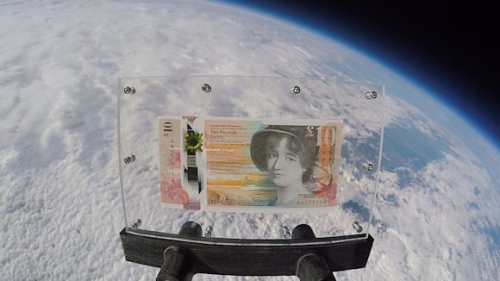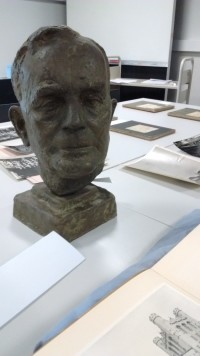Posts by: Matin Durrani
Why money is tight for Japanese science
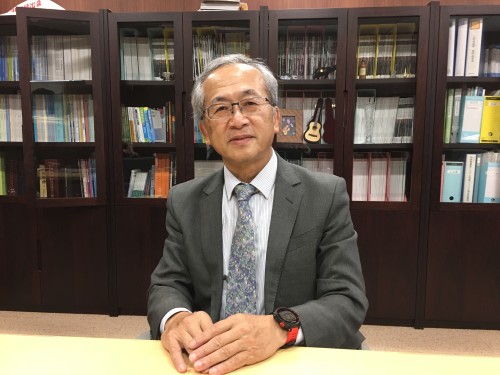
Money matters: Yasuhiro Iye is an executive director of the Japan Society for the Promotion of Science. (Courtesy: Matin Durrani)
By Matin Durrani in Tokyo, Japan
“Budget.”
That was the one-word answer from Yasuhiro Iye, when I asked him what was the most important thing on his mind as executive director of the Japan Society for the Promotion of Science (JSPS).
The society, which was founded in 1932, is responsible for funding researchers in Japan across all sectors of science, engineering and humanities. In 2015 the JSPS distributed about ¥260bn (about $2.27bn) in grants, which are awarded competitively through a rigorous peer-review process, with physicists receiving roughly 15% of the total.
It might sound a lot of money, but as Iye points out, the JSPS’s total budget has been pretty static in recent years. Money for science, Iye admits, is not as generous in Japan as in the past, which he blames on rising social-security costs to deal with the growing number of old people. “The Japanese government budget is constrained by the cost of an ageing society,” Iye says.
View all posts by this author | View this author's profile
Under the sea: the November 2017 issue of Physics World is now out
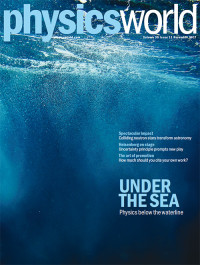 By Matin Durrani
By Matin Durrani
Physicists love a challenge. Some have experiments up in space, while others work deep underground or at the tops of mountains. But just imagine how hard it must be for the those physicists who do experiments at sea.
The November 2017 issue of Physics World, which is now out in print and digital format, examines some of the challenges for physicists working below the waterline.
Jon Willis describes his experience on the exploration ship Nautilus in the Pacific Ocean, looking for mineral-rich “black smokers” that support life in conditions mimicking those on Jupiter’s icy moon Europa. Helen Czerski reveals why her studies of bubbles could help those who model climate change, while Antoine Kouchner and Véronique Van Elewyck explain why and how researchers are using the ocean as a giant neutrino detector.
Remember that if you’re a member of the Institute of Physics, you can read the whole of Physics World magazine every month via our digital apps for iOS, Android and Web browsers.
View all posts by this author | View this author's profile
A rockin’ good milkshake, a telescope that wants to be the next Taj Mahal
By Matin Durrani and Hamish Johnston
Film fans will well remember the opening scene from Back to the Future, in which Marty McFly (played by Michael J Fox) is thrown across a room by a massive sound wave from an enormous guitar amp. It’s more science fiction than science fact, but to illustrate the impact that sound can have on everyday life, staff at EngineeringUK have come up with something really rather clever. To drum up interest in next year’s science-careers show The Big Bang Fair, which is to be held in March in Birmingham, UK, they’ve built what they dub a “Rock Music Milkshake Mixer”.
View all posts by this author | View this author's profile
A tenner in space, why just 0.3% of LIGO bagged the Nobel, sounding-off in Havana
By Hamish Johnston and Matin Durrani
Primary school children in Scotland have celebrated the launch of a new £10 note by launching it into space. Well, sort of. The Royal Bank of Scotland note was actually sent aloft on a high-altitude balloon with a camera to capture the event for posterity.
If you know your astronomers, you will recognize Mary Sommerville on the tenner. She was active in the early 19th century and famously predicted the existence of Neptune by its influence on the orbit of Uranus. She and Caroline Herschel were the first women to be members of the Royal Astronomical Society and she also wrote the bestselling science book On the Connexion of the Physical Sciences.
There is much more about Sommerville in our podcast “Mary, Queen of Scottish banknotes“.
View all posts by this author | View this author's profile
The physics of bread, the quest for metallic hydrogen and adventures in LIGO land
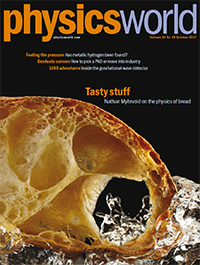 By Matin Durrani
By Matin Durrani
If you’re a student wondering whether to go into research or bag a job in industry, don’t miss our latest Graduate Careers special, which you can read in the October issue of Physics World.
Philip Judge from the US National Center for Atmospheric Research and his colleagues Isabel Lipartito and Robert Casini first describe how budding researchers should pick a PhD to work on. It’s vital as that first project can determine the trajectory of your future career.
But if your eyes are set on a job outside academia, careers guru Crystal Bailey from the American Physical Society runs through your options and calls on academics to learn more about what’s on offer so they can advise their students better.
If you’d rather just stick your head in the sand about your career options, however, then why not enjoy the cover feature of the October issue, in which former Microsoft chief tech officer and Intellectual Ventures boss Nathan Myhrvold discusses his massive new five-volume treatise Modernist Bread.
Mixing history and science – as well as the results of more than 1600 of his own experiments – the book is sure to be the last word on this foodstuff that humans have been baking for millennia.
Don’t miss either Jon Cartwright’s feature on the quest for metallic hydrogen.
Remember that if you’re a member of the Institute of Physics, you can read the whole of Physics World magazine every month via our digital apps for iOS, Android and Web browsers.
View all posts by this author | View this author's profile
In the footsteps of Cecil Powell
By Matin Durrani
I spent yesterday at the University of Bristol, where a meeting was held to celebrate the 70th anniversary of the discovery of the pion in 1947.
The particle was spotted by Cecil Powell, who joined the university’s physics department in 1928 and went on to win the 1950 Nobel Prize for Physics for his efforts.
At the time, the pion was thought to be the carrier of the strong nuclear force, which binds protons and neutrons in the nucleus, though we now know it is one of a family of strongly interacting mesons.
As we heard yesterday from introductory speaker Brian Pollard, Powell found evidence for the pion using a series of ingenious (and literally breathtaking) experiments that involved him taking specially manufactured photographic plates to high altitudes up the Pic-du-Midi mountain in the Pyrenees.
View all posts by this author | View this author's profile
The September 2017 issue of Physics World magazine is now out
 By Matin Durrani
By Matin Durrani
Some of the daily challenges facing women in physics are tackled in the latest issue of Physics World magazine, which is now out.
As well as a round-up from the recent International Conference on Women in Physics, which took place in Birmingham, UK, there’s a fascinating feature about the life of Jocelyn Bell Burnell. She discovered pulsars 50 years ago next month and became the first female president of the Institute of Physics, which publishes Physics World.
As Bell Burnell points out, “Fix the women!” is often seen as the solution to why women progress more slowly in physics than men. In fact, she argues, larger problems – notably institutional bias and poor policies – are to blame.
Don’t miss either our cover feature on the stunning images Cassini has been beaming back over the last few months before it plunges into Saturn on 15 September. We’ve also got a great Lateral Thoughts article by Daniel Whiteson, illustrated by PHD Comics artist Jorge Cham. Plus, find out how groups of cells move, communicate and organize themselves in networks.
Remember that if you’re a member of the Institute of Physics, you can read Physics World magazine every month via our digital apps for iOS, Android and Web browsers.
View all posts by this author | View this author's profile
The August 2017 issue of Physics World is now out
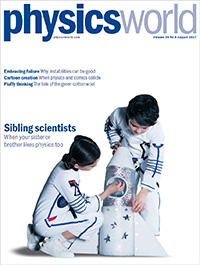 By Matin Durrani
By Matin Durrani
Who inspired you to study physics? Perhaps you had a great teacher or a supportive parent. But how might it feel if you’ve got a sibling who’s also into the subject? Would they be your rival or would the two of you support and nurture each other?
These issues facing “sibling scientists” are the cover feature of the August issue of Physics World magazine, which is now out. Turns out that sibling scientists are generally a force for good, especially with the elder child acting as a mentor and guide – often providing information, support and advice to the younger sister or brother.
I wonder in fact if we should do more to encourage boys and girls who are already in thrall with physics to persuade their siblings into the subject too. Of course, our feature isn’t an exhaustive scientific study, so do tell us if you know of other examples of sibling science.
Remember that if you’re a member of the Institute of Physics, you can read Physics World magazine every month via our digital apps for iOS, Android and Web browsers.
View all posts by this author | View this author's profile
Our hazardous planet: when the world is out to get you
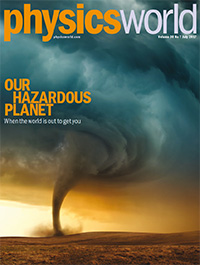 By Matin Durrani
By Matin Durrani
For people afflicted by last month’s devastating fire at Grenfell Tower in London or for those caught up in recent terrorist atrocities, it can seem that many problems in this world are entirely of our own making.
Yes the modern world has benefited from our collective wisdom and creativity – especially through science and engineering – but often it feels as if irrational human behaviour lies at the root of many of our troubles.
Nevertheless, we should remember that our planet itself holds many natural hazards too, as the latest special issue of Physics World reminds us.
Remember that if you’re a member of the Institute of Physics, you can read Physics World magazine every month via our digital apps for iOS, Android and Web browsers.
View all posts by this author | View this author's profile
Happy birthday Fermilab
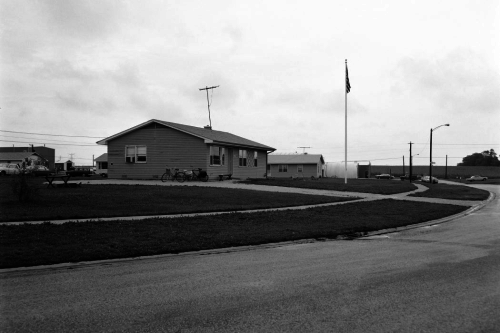
Little house on the prairie: the first director’s office on the National Accelerator Laboratory site. (Courtesy: Fermilab)
By Matin Durrani
Music lovers will remember 1967 as the year the Beatles released Sgt. Pepper’s Lonely Hearts Club Band. For sports fans it was the year when Celtic became the first British team to win football’s European Cup. As for scientists, 1967 will go down in history as the year in which the first human heart transplant took place and the first radio pulsars were detected by Jocelyn Bell Burnell, Antony Hewish and others at the University of Cambridge, UK.
View all posts by this author | View this author's profile

